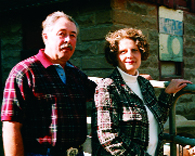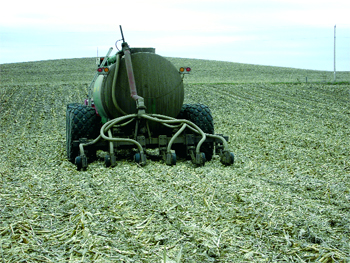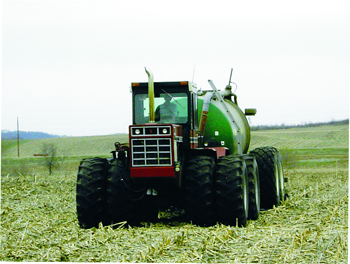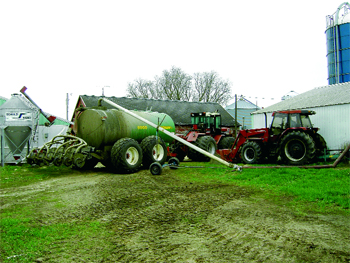
Wisconsin
hog farmer Lynn Harrison—with his equipment combination of a
6,000-gallon Balzer manure tank with a Yetter Avenger coulter injection
system—is part of a farm-based research effort which is yielding some
quality manure management information.
Wisconsin hog farmer Lynn Harrison—with his equipment combination of a 6,000-gallon Balzer manure tank with a Yetter Avenger coulter injection system—is part of a farm-based research effort which is yielding some quality manure management information.
Wisconsin hog farmer Lynn Harrison believes that it’s worthwhile for farmers to support quality scientific research regarding manure management. That’s especially true if you consider the alternative: not being involved with research efforts, and seeing unrealistic manure management rules passed by state legislatures, rules that end up having a severe financial impact on farm businesses.
 Lynn Harrison (left) and Pat Harrison. Lynn Harrison (left) and Pat Harrison. |
Harrison has joined the state’s producer-driven Wisconsin Agriculture Stewardship Initiative (WASI) as a Discovery Farm. WASI involves cooperation between farmers and researchers from the University of Wisconsin. The Harrison farm provides an opportunity for cooperation between his Discovery Farm and research at the University of Wisconsin’s Madison College of Agriculture and Life Sciences and UW’s Platteville Pioneer Farm.
“We need to have facts and scientific research behind the regulations,” Harrison says. “Farmers need to be able to live with the regulations and protect the environment, but they still need to make a living.”
He fears situations where figures are pulled out of the air or gathered from another industry and applied to the regulations pertaining to such manure management issues as hydrogen sulfide emissions or phosphorus content in soil, without a firm understanding of the financial consequences or even if the benchmarks are appropriate.
If, for example, the state dictated that the manure application rate on farmland must be reduced from 3,000 to 1,000 gallons per acre, that would mean that farmers would need three times as much land to apply the manure; it would drive up the price of land, applying the manure would take more time, and farmers would burn more fuel. “There’s more than one impact with issues like this,” Harrison comments. “So developing the facts and figures to be able to show what happens when a certain rate is applied is vital.”
He understands that there is a risk of public exposure in participating in high profile research programs as a Discovery Farm and also that the cooperative research may not always be in the farmer’s favor. It just means that farmers have to behave more responsibly if the science shows that changes are
warranted.
“If the research shows that we need to cut back on manure to make things better, then that’s what we need to do,” Harrison says. “We can’t be polluting water and soil. We have to be good stewards of the land.”
 The two million gallons of manure that are generated by the 10,000 hog-finishing operation is injected on to the Harrisons’ crop land. They grow corn and soybean on 700 acres. The two million gallons of manure that are generated by the 10,000 hog-finishing operation is injected on to the Harrisons’ crop land. They grow corn and soybean on 700 acres. |
As a no-till crop grower for the past 12 years in addition to being a hog producer, he knows the meaning of good stewardship when it comes to land conservation.
Lynn and Pat Harrison grow corn and soybean on 700 acres and also operate a 10,000-hog finishing business. The two million gallons of manure that the hog operation generates annually is injected into their crop land. The Harrisons recently sold 300 acres of land for development, yet continue to farm and apply manure right within the village boundaries. In fact, there is a school located about two blocks from some of their farmland. Their property is also located near the Muddy Creek State Wildlife Area and Old Elk Lake, a unique and somewhat rare shallow prairie pothole lake. To balance the significant pressure for housing development from the nearby city of Eau Claire, the Harrisons sold the development rights on 350 acres to Wisconsin’s Department of Natural Resources, and sold them 77 acres outright on land adjoining Old Elk Lake.
“It’s a philosophical thing,” says Lynn. “We could have gotten a lot more subdividing, but now half of the lake shore will never be developed.”
He says the farm’s no-till land management approach has been a greater influence on their manure management practices than their close proximity to these environmentally sensitive areas. With no-till, there is considerable crop residue left on the land to combat soil erosion. About a third of their acreage has been rated as highly erodible land (HEL), which is farmed in contour
no-till strips.
 When the Harrison farm went no-till, the Harrisons couldn’t find a manure injector that would inject the manure without covering a lot of the residue. They finally discovered a combination that works: a 6,000-gallon Balzer tank with a Yetter Avenger coulter system. When the Harrison farm went no-till, the Harrisons couldn’t find a manure injector that would inject the manure without covering a lot of the residue. They finally discovered a combination that works: a 6,000-gallon Balzer tank with a Yetter Avenger coulter system. |
“When we went to no-till, for several years we couldn’t find a manure injector that would inject the manure without covering a lot of our residue,” Lynn says.
“So we were out of compliance with our farm management plan.”
They finally discovered a combination that worked—a 6,000-gallon Balzer manure tank with a Yetter Avenger coulter injection system. The farm has been injecting its manure since 1998. “It was the first injection system we saw that would work in our no-till situation where it didn’t incorporate too much on the residue,” says Lynn.
Manufactured in Colchester, Illinois, by Yetter Manufacturing Company, the injector is suitable for deep placement of manure with minimal loss of ground cover and soil disturbance in all tillage conditions. It is designed to eliminate the plugging and dragging that occurs with big knives and shanks used in some other manure injection systems.
By using a narrow three-inch drop tube, the pressurized liquid is put into a narrow trench cut in grass or soil by a coulter. Each coulter system, in conjunction with its spring tension nylon wheel and steel wear plate positioned at an angle to the coulter, protects the injection tube, cleans the coulter and directs the manure into the soil cut. The 25-inch coulter blade is set at a five-degree angle for a clean soil cut.
Weighing in at approximately 253 pounds, the Yetter Avenger is constructed with heavy-duty cast linkage that maintains uniform spacing and stability. It also comes equipped with tapered roller bearings for longer life. A nylon wiper wheel with spring pressure eliminates blade soil build-up. It fits on either a five-inch by seven-inch or seven-inch by seven-inch toolbar. Options include disc or residue wheel sealers, which the company says virtually eliminates odor.
“We’ve noticed a significant change with injecting the manure instead of spreading it on top,” says Harrison. “We get less odor, less chance of run-off, and we save a bit more nitrogen by injecting.”
Yetter also offers an Avenger Injector with a 30-inch coulter blade, suitable for deep injection of up to 12 inches. The company has been in business since 1930, and began as a small rural machine shop owned by Harry and Etta Yetter. It is still a family-owned business, now in the fourth generation, with an expanded product line that includes cultiguards, coulters, and a full line of farm products.
The manure on the Harrison farm falls through slatted floors into eight-foot deep collection pits below the barn floor. The barn is equipped with a pump out port where—in the fall—Harrison uses a Houle pump to transfer the manure from the pits to the manure spreader.
 One of the studies the farm is hoping to participate in involves variable rate manure application. This would help the Harrison farm micro-manage its application rate so that it can be adjusted in areas with high phosphorous content. One of the studies the farm is hoping to participate in involves variable rate manure application. This would help the Harrison farm micro-manage its application rate so that it can be adjusted in areas with high phosphorous content.
|
One of the most serious issues faced by farmers in this area of Wisconsin is the extremely high phosphorous content in the soil. As part of its participation in the WASI/Discovery Farms program, the Harrison farm is hoping to participate in a study investigating variable rate manure application technology. This technology will help the Harrison farm micro-manage its application rate so that it can be adjusted in areas with high phosphorous content.
“You can vary the application rate of your manure based on yield,” says Harrison, “so that we’ll essentially be matching our soil tests with yield and manure analysis to put on whatever amount of manure that we’d need for the next crop year, probably based on phosphorous content.”
He says the technology to support that type of application already exists; Balzer has a variable rate flow valve that will allow for variation of the application rate as the manure tank travels across the field.
Flow rate adjustments can also be tied into Global Positioning System (GPS) technology, which gives the farmer an exact reading of where he is on his field and what the application rate should be at that point based on soil tests.
What the farm needs is assistance from the College of Agriculture and Life Sciences scientists to test the technology and application method so that they can apply it with confidence as a standard practice, so that both the phosphorous control issue is dealt with and the farm realizes maximum nutrient value from injecting the manure.
For now, the Harrison farm is being used as a laboratory to compare the manure application rate to planting distance in relation to the manure injection point. This is to determine the best placement location for nutrient uptake to ultimately achieve the best crop yield. For years, farmers have been placing starter commercial fertilizer two inches over and two inches down from the location where corn is planted, and what they need to know is if using manure as the starter fertilizer delivers the same predictable yield.
“I’m of the opinion that manure has different characteristics that should be investigated,” says Harrison. “If it’s fall-applied manure, we may be able to plant right over top of it to get the best yield, but we don’t know that for sure.”
Harrison says when participating in research programs like Discovery Farms, there is give and take between the university and the farm location. Farmers agree to provide the larger laboratory setting to allow scientists to gather the information they need as part of their research agenda. Along the way, the farmer hopefully has the opportunity to request an area of scientific study that addresses a specific need, such as the best technology and approach to variable rate manure application.
“The WASI program is important for Wisconsin farmers because it does bring research to the farm quicker,” Harrison concludes. “And because the research is farm-based, it is being done on a bigger scale.”